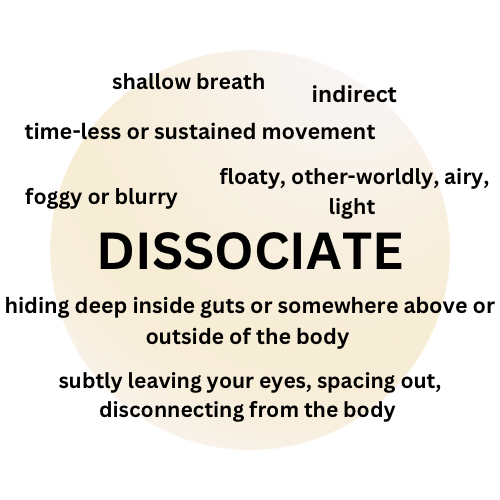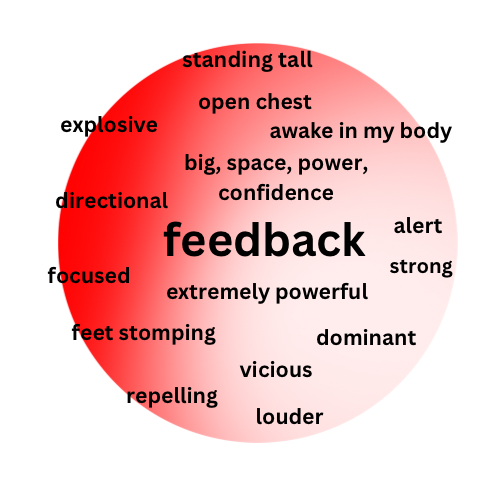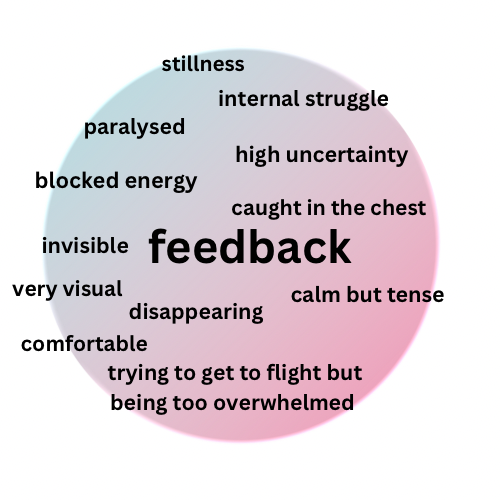
Movement Direction & Choreography Video Portfolio
Selected rehearsals, research workshops, process
For my performance CV please click here
Movement Direction & Performance - ‘Persona’ Focus Art Fair 2023 at the Saatchi Gallery, London.
I developed the character of ‘Persona’ & created a nuanced physical language of gesture & posture that portrays the full spectrum of human emotion, so that from within her portrait, Persona can interact in real time with the person sat opposite her. This vast range of expressive gesture had to be precise & repeatable, in order to be labelled & fed into an AI engine, that chooses a given interaction based on the observer’s body language.
Using Yat-Laban movement psychology & embodied imagination I developed a unique character story for each quality of movement required, that allowed me to access a different emotional & physical state. I created 192 named variations in physical gesture & emotional state, & performed these in sequence via performance capture at Centroid studios. This footage was then animated into the digital portrait
We exhibited ‘Persona’ at The Focus Art Fair at the Saatchi Gallery in 2023 and have recently been named as a 2024 finalist in one of the most prestigious global art-tech prizes, The Lumen Prize.
Video 1: Behind the scenes footage on the making of Persona & Interview clips. I talk about my process as a movement artist.
Video 2: Persona at the Focus Art Fair - Saatchi Gallery (Oct 2023) & Public feedback.
Trauma-Sensitive ‘Character Movement’ Research as Practice Workshop - 2023
I led my first free R&D actor-movement workshop, entitled “Befriending protective responses for character embodiment.” I took the actors through an in-depth physical exploration of each human protective response: flight, appease, fight, freeze & dissociate. I use animal-based improvisations, giving the actors an embodied insight into how the nervous system affects the way a character habitually moves & the creative possibilities of creating character through this framework. I work carefully to hold a trauma-sensitive collaborative space & to use nervous system regulating tools between each exploration.
Below is a selection of anonymous feedback that participants wrote down (words, images, and sensations), alongside some of the somatic shaping elements that I used to guide the improvisation.
“You held the room absolutely brilliantly. I thought the work of going in through animals was brilliant, there’s loads of scope there. Really well paced and good fun. The reflecting, sharing and writing phase felt just as nourishing as the doing from an actor’s perspective. There were loads of discussions to be had and talking points around it.” (Participant feedback, 2023)
In-depth description & reflection:
To test out how Polyvagal Theory could influence development of character embodiment I designed a practice as research workshop based upon Haines’ descriptions of how protective responses shape the soma.
I offered an introduction to and signposting of the work ahead, and how the space would be held to invite actors to move from the centre of the work to the periphery - onion style and invited them to attend to their bodies’ needs. We began with a landing exercise including small circles with hands on the heart centre to invite vagal tone and deepen the breath. An invigorating limber including circle formations to invite co-regulation, a consent-based exercise to invite attending to neuroception and a noticing of their own autonomic states and, finally, the moving through space exercise to invite soft focus, use of space, and play, before entering the main body of the work; Befriending protective responses for character embodiment.
The body of this practice as research consisted of five distinct animal-based improvisations for each autonomic protective state, in the following order: flight, appease/fawn, fight, freeze, dissociate. I read out dictionary definitions of each state to the actors (see video) before guiding a transformative creature improvisation that allowed the body of the creature to emerge to the actor.
As they began to test out their first steps, crawls, hops, slithers from their egg, nest, tree, ocean bed; I introduced phrases and images of the protective state for the actors to explore through their creature body and asked them to notice and respond to being in proximity to other creatures around them or environmental sounds from this world and to use their full physicality and breath to do so. What emerged was a room full of unique creatures and movements that all embodied the heightened energy of the protective state - the social engagement system in full threat. The actors could feel the full protective state in action and then release it and cycle back to a neutral animal state.
We then played with bringing the creatures under the skin into a human form, the protective impulses were now just impulses, not enacted, living in their tissues as they moved in and out of proximity with each other. I introduced words and images of how the soma is shaped when these impulses are not allowed and are sustained, for example, flight could be ‘a slight turned away position’ or fight could be a ‘taking up more space.’ The offers were for actors to engage and notice breath, eyeline, weight, space they are taking or relinquishing, direct/indirect movement or shape of movement, and tension levels.
After each improvisational state I led a short cool down, to release the state/character and come back, to what I would now call a vagal-anchor or a landing place. From the mobilising states of flight, fight and appease, a full-bodied shake out, which is what animals do naturally to release threat states, and then a roll through the spine, ‘releasing the state into the ground’ and coming back to centre. From the immobilising states, particularly from dissociate, I extended the cool down to gently bring attention and sensation back into the body, patting the skin to feel the container of the body, dropping the breath into the belly, feet grounding, before walking and noticing coloured objects in the environment that are satisfying.
After each exploration I gathered us for a few minutes of individual feedback on paper but mostly in dialogue with each other. I sensed the group connected over these experienced states; it was co-regulating. The tone was “playful, interested, curious, relaxed, open and the conversations could have gone on and on.” (Working journal, 2023). These dialogues also served as a landing spot to integrate the work, and for me to observe in real time the experiences of the group, make adjustments and allow some space before the next state transformation. I was careful to guide the feedback away from personal narratives and toward body sensation, images, and textures. One participant observed, “this goes for every exercise that we’ve done, it really puts you in your senses. Smell, hearing, sight, all of it.”
Naturally, the imaginations and senses were awakened, and creature stories/characters emerged. The individual states became the foundation for unique creature bodies, that morphed into more subtle and complex human forms; creating collective shifts of energy within the space and affecting relational proximity and power hierarchies.
Shifts of autonomic states within the actors’ bodies opened new physically expressive experiences. Through group feedback, I discovered there was a diversity of states feeling “familiar”, “in my toolbox” and “comfortable” or “unfamiliar”, “hard to do” and “uncomfortable”. The exploration of less familiar autonomic states could with practice open new ranges of expression for the actor, more choice and over time more spontaneity. This is representative of the diversity of soma shaping and diversity of the ways in which we interact with the world based on lived experience. I find this research useful to translate into researching and preparing for a play: to ask what clues to soma shaping choices are in the text and to harness this in collaboration and communication with the director, actors and creative team.
The use of creatures for exploration worked as a layer of safety by universalising and de- personalising the states. The opening limber and cool-downs as transitions were vital in contributing to the ventral-vagal state that held the sympathetic and dorsal-vagal states in a warm embrace, as the actors dipped into them and back out.
Collectively, the autonomic shifts in the room were palpable and could then be translated into movement directing crowd or chorus movement:
With flight there was a vibration in the air, a constant sense of alertness and movement potential; a quickening like a fast heartbeat; direct shifts of direction; a relational half in- half out.
In fawn/appease there was a cocktail of liveliness tempered with a subdued quality; moments of warmth and tentativeness, slipperiness, fluidity; use of space, levels and tempos; an indirect movement space; attentiveness to the other and mirroring.
The collective freeze I observed a heavy stillness in the room and a slowing of tempo; a lethargy; a holding of breath; effort; less use of space.
The collective fight energy felt weighty, energised; direct spatially; strong movements and focused eyes; engaged breaths.
Dissociation felt airy, light, other worldly; as though the participants were floating around whilst their bodies were in automatic, sustained, and indirect movement; unenergised.
I observed the power dynamics that arose during the exploration of fight, intuitively I sensed the need for a different closure to the exploration. I brought the actors into pairs and asked them to find a receptive gesture of power to share with their partner and to feel into their own power as well as receiving their partner’s gesture. This felt like both a more inclusive and empowering moment to close ‘fight’ on, that I would refine and integrate into future work with this state. This landing point could be applicable to appease, the other most relationally engaging protective state. As a relational exercise it could be interesting to activate these states and play with how proximity affects the internalised or externalised impulses to run, fight, freeze, appease or dissociate. If I had workshopped this further, I would have invited actors to embody different states in relation to each other, which would then lead to embodying more than one autonomic state. In life we use a range of protective autonomic strategies, but we also have more access to certain protective strategies based on historical use of them.
Movement Director - Biscuits for Breakfast - Hampstead Theatre 2023
Biscuits for Breakfast is a foodie love story between Paul, who is a passionate amateur chef & Joanne; he impresses her with his culinary skills, they bond over home-cooked meals… and then food poverty, hunger & despair. Part of my creative brief from director Tessa Walker was to create the physical language of ‘cooking & eating’ with no props (or miming!). I worked with the actors using sensory exercises (such as sharing a blood orange across a table) - finding the physical gestures of pleasure through the senses, breath, eye contact, space between them to create a shared physical language of eating together. Paul’s cooking gestures came from physicalising actual recipes & allowing movement to emerge through the actor Ben, into an almost dance-like ritual; which in turn was fragmented and twisted during moments of delirium from hunger. I used nervous system regulating moments within scene transitions to gift the actors (and the audience) moments to breathe, connect & anchor in a play that is emotionally and physically demanding to sustain for the two actors over a long theatrical run.
I received mentions for my movement work in The Stage & The Times (4 stars)
Playwright & Theatre Director Terry Johnson commented: “Ms Wield’s work on Biscuits for Breakfast elevated an understated drama into an eloquent, mesmerising piece of theatre. In 90 minutes she alerted me to the potential of collaborating with a movement director who respects and revels in the text.”
Play by Gareth Farr, directed by Tessa Walker at Hampstead Theatre Downstairs in 2023. Actors featured: Ben-Castle Gibb & Boadicea Ricketts.
Video 1: Tech rehearsal footage
Video 2: Devising movement in rehearsal











